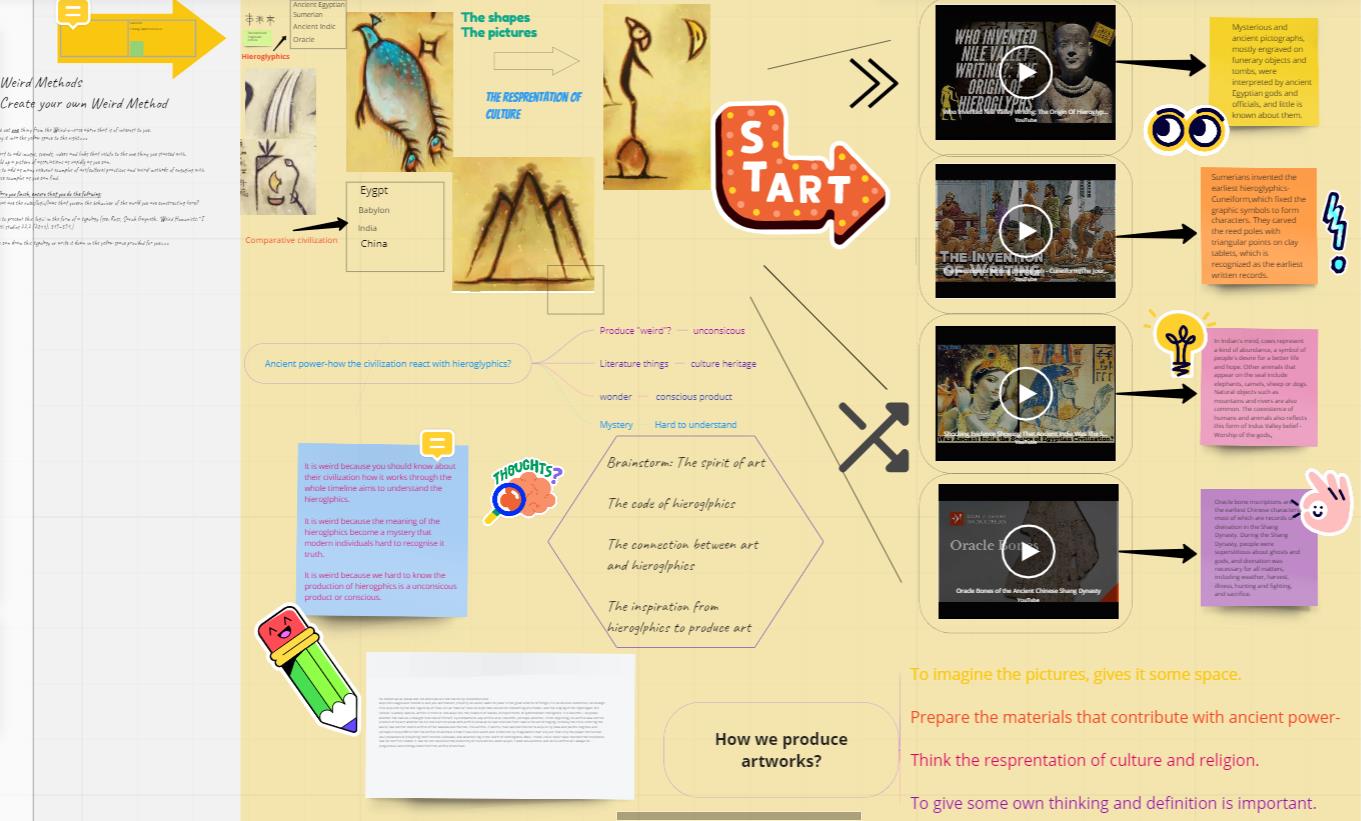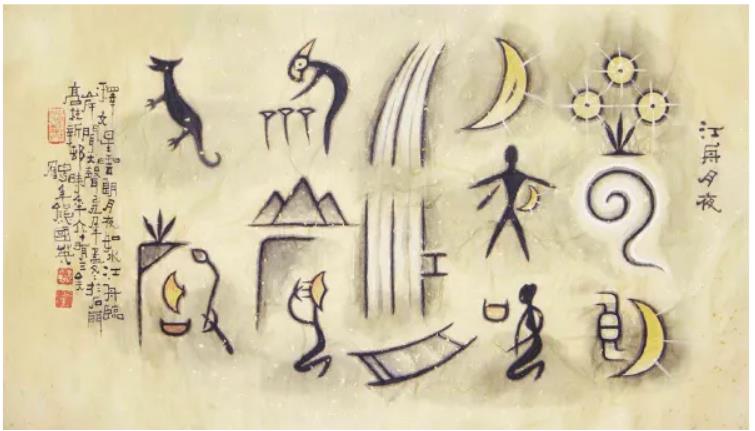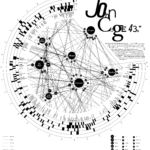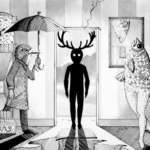The weird
The theme of our study in the past two weeks is weird. This macroscopic view of theme covers many small topics, such as mysticism, hauntology, esotericism. Also such as conspiracy theory, ancient hieroglyphs, surrealism, discordianism, and all other theoretical knowledge that cannot be explained by scientific experiments. It is difficult for all metaphysical theories to prove your own theories or assumptions with evidence. I think this is a quite huge difficulty in art learning due to a study of unknown and imperceptible .

In the theme group seminar, I chose the narrow theme of ancient hieroglyphs. The study of comparative civilization, it includes ancient Egyptian characters, Sumerian characters, ancient Indian characters and ancient Chinese oracle bone inscriptions. They are the earliest characters in the history of human civilization. Their similarities are that they are transformed from pictures, slowly forming characters, and forming their own unique cultural atmosphere. However, the purposes of hieroglyphs in different civilizations are also different. For example, mysterious and ancient pictographs, mostly engraved on funerary objects and tombs, they were interpreted by ancient Egyptian gods and priests, but little known about them in a folk society. Sumerians invented the earliest hieroglyphics-Cuneiform, which fixed the graphic symbols to form characters. They carved the reed poles with triangular points on clay tablets, which is recognized as the earliest written records. Furthermore, in Indian culture background, cows represent a kind of abundance, a symbol of desire of individual for a better life and hope. Other animals that appear on the seal include elephants, camels, sheep or dogs. Natural objects such as mountains and rivers are also common. The coexistence of humans and animals also reflects this form of Indus relief-Worship of the gods. The last one is Chinese hieroglyphs-Oracle bone inscriptions are the earliest Chinese characters. Most of which are records of divination in the Shang dynasty. During the Shang dynasty, people were superstitious about ghosts and gods, and divination was necessary for all matters, including weather, harvest, illness, hunting activities or fighting, and sacrifice. To sum up, from pictorial characters to hieroglyphs, the process of cultural transition is either an unconscious or a conscious act of inheritance, or an unconscious record that created the later civilization, which is unknown to us later generations. This weird unknown field, which can not be proved by science, has historical traces, and how can we learn some evidence that can be proved, and our ideas become clearer and logical, This is a difficult problem when I am doing weird theme.
The neologism with the study of cognitive system and lost languages, I wrote is a combination of two words, one is cogni, another is mystery, which combines to a word-cognistery. Because I think the theme of weird is a human exploration of cognitive fields on brain based on neuroscience, therefore I created this new word. After reading the paper related to terms of pareidolia, illusion is a cultural phenomenon formed by combining two completely unrelated things or random data. For example, pareidolia leads the ‘rock art’ with psychological evidence in cognitive visual system, it points out ” once the brain has been conditioned to anticipate specific patterns, it tends to discover them with minimal stimulation, because most of the information processed by the human visual centre derives from within the brain”.(Bednarik 2017) Such as a neural bed transmission in our brain. Neuroscience belongs to the modern science of psychology. It has relevant basis, thus from this point of view, some associations or symptoms that seem to sound ridiculous can be supported by science contains settled explanations.
Furthermore, it is can be considered that there was some connections or similarities between pareidolia and conspiracy theory, which is a category in the field of philosophy. It is an ideology, a generalization of a kind of intrigue created by people, and a tendency to distort facts in cognitive brain thinking. Also, it is a way for the human brain to create new stories, and the artistic form it creates may be a novel rather than a fact. Interest groups can achieve the goal of benefiting themselves at the expense of others. The factual basis of the conspiracy theory is very untenable. It is the same as the pareidolia that is granted by the subjective brain of the individual. Therefore, the idea of associate thinking is the main concept that to understand both the phenomena behind pareidolia and conspiracy theory. The definition of ‘abnormal meaningfulness’ is “neurologically rooted in the ability of the brain to sift through the mass of sensory information received to detect significant signals. (Bednarik 2017) Therefore, a cognitive learning behavior was produced by conspiracy theory and the practices with rock of art due to pareidolia.
In addition, weird studies can be learned, and can also be imagined and created. It is controversial, such as the discussion of constellations. Some people believe that there is something, and others do not believe that there is nothing. But at the same time, there are some scientific theories about the astrolabe fixed explanation. Then to the brain cognitive neuroscience pointed out by the illusion. It can be seen that eccentric learning has a certain fixed scientific explanation. It gives some scientific basis from seemingly unrelated things, and then conspiracy theory creates a new story from the report of facts. Moreover, the birth of artworks is also based on a cultural background, which we give a academic word-‘Cultic mileu’. A large cultural civilization is very conducive to individual’s artistic creation, giving full play to the imagination, and creativity of the human brain. Our brain receives information and perceives information related to cultural background, and as a heritage, we constantly learn previous knowledge from the ancients, and then create our own theory. After a long time, the human brain becomes accustomed to the same perceptual information, which will become a settled behavior and create a series of frame artworks.
To sum up, due to the ‘cultic mileu’, the cognition of brain has become a habitual visual system , whether it is ancient Egyptian hieroglyphs or oracle bone inscriptions, or rock murals and other works of art. There is no doubt that they are ancient art treasures, a kind of inheritance of spiritual culture. From the perspective of modern science, we can explain some cognitive behavior of ancient people at that time, and give us some information about how they created these works of art. This unconscious behavior creation method has inspired and reflected on contemporary art civilization. A new age of art is called contemporary art creation, which has lasted for nearly a hundred years, and gives future generations a new inspiration for art creation.
References:
Bednarik. (2017). PAREIDOLIA AND ROCK ART INTERPRETATION. Anthropologie (Brno), 55(1/2), 101–117.







Kneel, Mulholland: Drive!
12th October 2022 — 12:24 pm
A few comments on what you have posted for Sprint 1:
I enjoyed this Tianai. The hieroglyphics starting point in in Miro has created a rich area of research that culminates in your imaginative and informed use of the ‘cultic mileu’ as a form of habit that enables social production.
Hieroglyphics forms part of a broader area of knowledge concerning indecipherable texts and related lost languages. The most famous example is the Rosetta Stone https://en.wikipedia.org/wiki/Rosetta_Stone which took a long time to decipher. In terms of The Weird, the act of deciphering renders something no longer ‘weird’ insofar as it gives us insight. The deciphered is the unknowable known. A Weird aesthetics often attempts to foreground what we cannot, or should not, know. Possibly the best expression of this line of inquiry in aesthetics is Arthur Machen’s book Machen, A. Hieroglyphics, Project Gutenberg. Read it here: https://www.gutenberg.org/ebooks/40241 Given where you started with the Weird, you’re likely to get something from Machen.
This is something that’s grounded within the Problem Scenario. To pose and try to answer these kinds of questions, you’d need to unpick the Problem Scenario a little more – see: https://blogs.ed.ac.uk/macat/openlearninghandbook/problemscenario/ If you think you might benefit from a scholarly source that attempts to outline the Weird try Noys, B. & Murphy, T.S. (2016) Introduction: Old and New Weird. Genre (Norman, Okla.). 49 (2), 117–134. doi:10.1215/00166928-3512285.
What might you do differently here?
How might you connect your neologism with the study of indecipherable texts and related lost languages? The pareidolia aspect of your research here also provides a clear link through to Conspiracy Theories. What could you do differently if you re-wrote this post with pareidolia as as they key concept uniting all the different aspects of your work here?
Editing the post: Change the title of the post to e.g. Theme 1 | Weird. Currently the title of your post is https://miro.com/app/board/uXjVPUMaK1M=/
Accessibility of the post: The background of the post needs to be more transparent and your text needs to contrast with it – it’s not readable as it is. See: https://udlguidelines.cast.org/ for more on how to make things more accessible.
s2298567
21st October 2022 — 1:47 pm
I like your post very much, after reading your post, I further understand the theme of ancient hieroglyphics. Your post covers many aspects, including conspiracy theories, horoscopes and so on, which is also what I need to learn from you. 🧐☀️
s2341920
22nd October 2022 — 10:40 pm
From the article you can see that the author has done a lot of research on his theme, provided a lot of relevant knowledge and has linked the knowledge points together This is worth learning